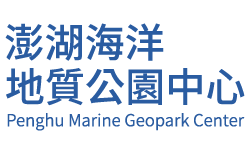Audio Tour-(24) Siliceous basalt
(24) Siliceous basalt

Introduce
The siliceous basalt is the main rock of the Penghu Islands. Its color is gray-black to dark gray-brown. Its composition granularity is medium to coarse. Its main constituent minerals are plagioclase, oblique pyroxeneilmenite. Its silicon dioxide content is higher, often greater than 49. The lava is produced by the partial melting of the upper mantle material at a depth of about 34 to 45 kilometersat an average temperature of about 700 to 900 °C. After the lava is ejected, it begins to cool slowly. Due to the difference in the percentage of minerals, it forms today’s thickbroad basalt columns, each of which is about 20 meters highabout 1 to 1.5 meters in diameter. For example, in the Penghu Islands, the rock columns of Hujing IsletTongpan Islet are the largestmost characteristic siliceous basalt columns, whose surface layer is oxidized to form a brown-red rust color. The specimens collected by this center are from Wukan Sea Cliff of Magong City.


